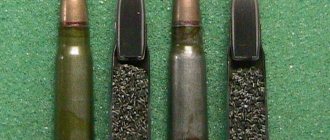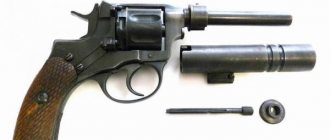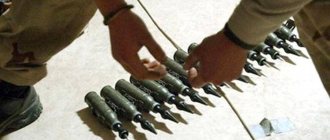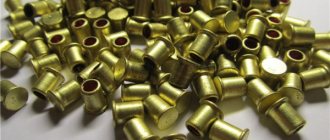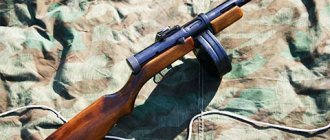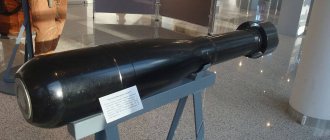In Dahl's dictionary
M. lat. patron, protector, or benefactor. | A paper tube for a gun charge (and a gun cap), and the entire charge. The cartridge is blank, with gunpowder; combat, and with a bullet. | factory blowing piston, or piston cup. | A lathe chuck is a short copper or iron tube into which the thing being turned is inserted. | Form, lyak; | pattern, sample for cutting, image; | stencil, slotted paper, for powder or brush. Regimental cartridge box, charger. Cartridge warper, chamber, stick for the beam of cartridges. The patroness bandolier m. bag for cartridges. A cartridge maker who makes cartridges.
Revolver Lefoshe
When the unitary cartridge appeared, its use in revolvers was not envisaged. The main purpose was long-barreled weapons. But since the rate of fire of revolvers needed to be developed, the adaptation of unitary models for them was associated with the appearance of a metal casing.
And here the gunsmith from France Casemir Lefauchet distinguished himself. First, he developed a unitary cartridge suitable for revolvers, and then the optimal weapon for them. And the first revolver chambered for a unitary cartridge looked like in the photo.
When the trigger is pulled, the hammer hits the top end of the pin. It directs the impulse to the capsule. It explodes. The gunpowder ignites. The resulting gases displace the bullet from the cartridge case. Thanks to them, the bullet accelerates strongly as it travels its way.
Another feature of the Lefoshe revolver is associated with the introduction of double-effect trigger technology. This made it possible to fire the weapon after manually pressing the trigger and simply pressing the trigger.
Gradually, the revolver with such a system had to be abandoned for the following reasons:
- The cartridge case pin was always in combat readiness. It was often accidentally hit, and the weapon fired spontaneously.
- In rare cases, gases from gunpowder hit the shooter's face.
- The sleeves expanded greatly. They were difficult to remove.
In Efremova's dictionary
Accent: cartridge
- m. Owner of an enterprise, company.
- decomposition Immediate superior, leader.
- A bullet or shot with a powder charge and a primer with an igniter, enclosed in a cartridge case.
- Sample for cutting (in sewing and furriery).
Classifications of metal unitary cartridges
There are only two of them:
- Models with seamless sleeves.
- Composite models.
In seamless cartridge cases of unitary cartridges, the bottom and the walls on the sides are a single whole. To create it, sheet brass with alternating hoods is used.
A thin sheet of brass is used to make the composite versions. It folds at least 1-2 turns. The separate bottom is firmly attached to the walls on the sides.
During the shot, the cartridge case expands. Its extreme sides touch the chamber tightly. It is easy to remove the cartridge case after a shot, even if the gap is significant.
Seamless variations operate without failures only with a modest gap - a maximum of half a point.
When the sleeve takes the proper shape, its inner walls are varnished. This protects the metal from oxidation. After which the capsule is placed in the bottom.
In the dictionary D.N. Ushakova
PATRON, patron, husband. (Latin, patronus - patron). 1. In ancient Rome - a full-fledged citizen, considered the patron and protector of his freedmen and clients (·ist.). 2. Head, owner of an enterprise (in bourgeois society; often ironic). "My soul! - answered Solomin - we started a school and a small hospital - and even then the patron resisted like a bear! A. Turgenev. 3. transfer Protector, patron. | For Catholics, a saint is considered the patron of the person who bears his name, or the patron, protector of some city, community (church). ·St. Mark is the patron of Venice. II. PATRON , patron, husband. (French patron). 1. The connection of a charge and a bullet or shot enclosed in a cartridge case. Live cartridge. Training cartridge. Hunting cartridge. 2. In lathes and drilling machines - a device that serves to strengthen the workpiece (or tool) in the rotating part of the machine (tech.). Cylindrical cartridge. 3. Part of an electric lighting device into which a light bulb is screwed in to connect it to the network (technical). 4. Sample for pattern (port.). Cartridge for fur collar. 5. In weaving: stenciling a design on fabric (tech.). 6. A paper tube into which tobacco is poured to make a cigarette, the same as a sleeve.
Categories of cartridges by position of the strike complex
According to this criterion, unitary cartridges are divided into the following groups:
- With ring fire. The impact complex is compressed inside the sleeve along the entire diameter of its bottom.
- With central fire. The complex is locked into a capsule and placed in the middle of the bottom.
All composite versions of cartridges belong to the second group. In the first group they would simply burst and there would be excessive gas pressure.
Well-known models from the first category are:
- 4.2-linear model for the Berdan rifle;
- 6-line version for Krnka rifles.
The Boxer model has gained enormous popularity among the component modifications.
In the dictionary Dictionary of foreign words
I
a, m.
1. A bullet (or shot) with a charge and a primer, enclosed in a cartridge case. The chamber is the rear portion of the bore of a firearm.
2. A hollow tube, cylinder for inserting, clamping, screwing something into various devices and devices. P. lathe. Tube item Patronka (special) - sample for pattern. Cartridge - relating to a cartridge, cartridges. Unpack (simple) - 1) unpack, stir up; 2) strongly scold. II
a, m., shower.
1. ist. In Dr. Rome: a noble Roman citizen (originally from the patricians), patron of clients and freedmen dependent on him and their defender in court.||Cf. SENIOR II, SUZEREN.
2. trans. outdated Patron, protector.
3. The owner of an enterprise, company.||Avg. BOSS, PRINCIPAL, CHEF.
4. decomposition Someone's immediate supervisor My p. is not in a good mood today.||Wed. CHEF.
Share the meaning of the word:
Long barrel for short cartridge
Trends in the US arms market often follow one another, but there are also those that are as stable as the American love for firearms itself. Thus, the popularity of long-barreled weapons - rifles and carbines - chambered for a pistol cartridge has not subsided. Below are seven weapon models that best characterize this trend, and some of them are similar to the famous Kalashnikov, which in itself is significant.
TNW Aero Survival Rifle
Marksmanship training is a niche where carbines chambered for 9mm ammunition, such as the Aero Survival Rifle from TNW, thrive. Eliminating the ammo difference between a long gun and a pistol is a solid strategy, and the TNW is one of the best tools to implement it. Quick-release barrels, blowback action and modular design allow the weapon to be quickly adapted to a range of ammunition: 22LR, .45 ACP, .40 S&W, 10mm and .357 SIG. This flexibility allows the weapon to be adapted to solve a wide variety of problems.
It is also a compact weapon: with a length of just over 40 cm when partially disassembled, the TNW carbine easily fits on board a boat, airplane or in the cab of a truck. The carbine uses magazines from Glock pistols, and the weapon itself is made of aircraft-grade aluminum.
WASR-M
This carbine has a wooden stock and fore-end, magazines from a Glock pistol, the most impressive of which is the 50-round one, and the weapon itself is similar to the Romanian Kalashnikov in 7.62 mm caliber. Although the weapon appears to be the creation of a mad gunsmith, it is a completely production model from Century Arms (Century International Arms), produced under the name WASR-M. Shooting from such a weapon does not cause fatal damage to the owner’s wallet - 9 mm ammunition is inexpensive compared to 7.62 mm, and WASR-M owners especially like to note this fact.
WASR-M is a weapon that completely copies its charismatic ancestor, to the point that the barrel, made using cold forging technology, has an AKM-type muzzle brake-compensator. By the way, imitation is not always beneficial - the mount for the optical sight is still installed on the side, which is inconvenient. WASR-M is quite heavy - it weighs almost 3.5 kg.
PSA AK-V MOE Rifle
Based on the design of the Russian Vityaz-SN submachine gun, the Palmetto State Armory has created a 9-mm carbine very similar in appearance for all Kalashnikov lovers. The same safety switch, bolt handle and even magazine release mechanism are available.
Although the AK-V occupies a special place in the line of 9mm carbines, the inside of this weapon does not look like the classic Kalashnikov. The principle of operation of the AK-V automatic is the recoil of the free shutter, which suggests that all similarities with the Vityaz-SN are purely external.
The Magpul body kit includes an AK Polymer Grip pistol grip, a Black Polymer Upper/Lower Handguard forend, and a specially created Black Magpul Zhukov (folding) Stock - in this form the weapon weighs just over 3 kg. The AK-V comes standard with a 35-round magazine.
Beretta CX4 Storm
This is a modern yet simple weapon that is great for home defense. The Beretta CX4 Storm is an accurate and maneuverable carbine that, with a length of 75 cm, weighs about 2.5 kg. Light weight is achieved by the fact that most parts are made of high-quality polyamide.
The carbine uses the same magazines as the Beretta 92, including extended ones. This is, without a doubt, a big plus in the eyes of owners of a classic pistol. As an undoubted advantage, we can note a forged chrome-plated barrel with a length of 420 mm, a modular design that allows you to modify the weapon to suit the shooter’s preferences, low recoil and a comfortable butt, as well as the presence of Picatinny rails.
Kalashnikov USA KR-9
Presented with pomp to the American public several years ago, this carbine, if not exceeded, then certainly lived up to expectations. The KR-9 is a true rock 'n' roll star with build quality, reliability and looks.
The design of the carbine is based on the Russian Vityaz-SN submachine gun. The KR-9 is equipped with double-stack magazines for 20 or 30 rounds, made of polymer. Their designer was inspired by the magazines used in the legendary Soviet PPS-43.
The carbine is equipped with a steel folding buttstock of the skeletal type, plastic handguards and a Picatinny rail on the receiver cover. The barrel is made with classic 1/2×28 threads, allowing the installation of any muzzle device. By default, the seller puts a suppressor on the barrel. For the ultra-wealthy shooters, there's the ELITE Series KR-9, which for $2,999 adds an impressive body kit, extended barrel, red dot sight, 30-round magazine, and a host of custom parts.
Ruger PC
Dusted off an old concept and created one of the most popular 9mm carbines, the PC-9. This model may not be new, but it is still included in the ratings of the best carbines on the US market.
The PC-9 has perhaps the simplest design of all similar models on the American arms market, but at the same time, professionals recommend this weapon as one of the most reliable 9 mm carbines. Its receiver and bolt are made of high-quality stainless steel, and the stock is made of impact-resistant polymer.
The PC-9 is sold with a Picatinny rail already installed, making it easier to mount a variety of sighting devices. Owners can use magazines from Security-9 and SR-series pistols from Ruger, as well as from Glock. Overall, this is a simple and reliable weapon that is great for home defense.
RAK-9
Following the popular weapons trends of the American market, the Italian (Chiappa Firearms) released its carbine chambered for the 9-mm Luger cartridge based on the Kalashnikov called RAK-9. With the exception of the magazine, in appearance it completely copies the legendary machine gun, but differs both in caliber and design.
The carbine is deprived of a long bolt frame with a piston, as in the AK; instead, a special bolt is used, which was redesigned and manufactured specifically for 9-mm ammunition. The gas tube with the barrel guard and the forend are made as similar as possible to an AK, but taking into account the specifics of using a much less powerful cartridge. Interestingly, the receiver, being completely redesigned, retained the features of the classic AK, and therefore is produced at a factory in Romania, specializing in the production of its own version of the Kalashnikov.
The sights of the RAK-9 are made like the AKM, and there is even a cleaning rod attached under the barrel, which, coupled with the wooden butt, further enhances the similarity. The most noticeable external difference between the RAK-9 and the AKM is the magazine receiver of the original design, while the weapon is designed to use magazines from the Beretta 92 pistol. Magazines from the Glock pistol can be used only after replacing the magazine receiver shaft. It can be purchased on the secondary market or ordered from the factory.
Characteristics
A user who frequently uses a drill should know and understand the sizes of chucks that are on the market. In addition to the difference in shank diameter, some require the purchase of a separate adapter or adapter.
By the maximum diameter of the shank you can understand how widely the clamping blades diverge.
In this case it is:
The first sizes are rare, the others are much more common. Based on the power and size of the drill, the manufacturer selects the optimally accessible shank diameter. If this is a small tool, the power of which is only 300 W, there is no point in putting a 0.16 cm chuck on it. If the user cannot clamp the required attachment with the existing chuck because the sizes do not match, then it becomes necessary to choose another one with a larger diameter.
It is worth taking into account the minimum permissible value of the shank diameter, which can be 0.5, 0.8, 1, 1.5, 2, 3 millimeters. It is worth noting that the value of 0.5 mm is found on cartridges that have a maximum value of 6.5 mm, and so on in increasing order.
Another characteristic that you definitely pay attention to when choosing a suitable cartridge is the seat. It can be of two types: threaded and conical.
Modern manufacturers prefer to use the first option in the design of the tool; the second is used on those drills where the maximum shank diameter is 16 mm.
The threaded connection plays an equally important role. It could be:
The most popular sizes are 3*8 and 1*2. They are used on shank diameters of 0.10 and 0.13 cm.
There is only one type of metric thread - M12, it is used for cartridges with a shank diameter of 0.1, 0.13, 0.16 cm.
Among the characteristics of cartridges, you can also select a seat, which is designated as:
In this case, the numbers are the diameter, which is written in millimeters.
The honing head also plays an important role, the design of which depends on the length and diameter of the hole.
They are available for holes:
Last but not least is the shaft, which can be fixed or flexible. The first is located in the drill body, the second is screwed on, its design contains a flexible hose, it allows you to use the tool in hard-to-reach places.
Design features
The design of the cartridge is based on the use of a cam or collet mechanism in its design. Thanks to the element on the tool, you can easily clamp attachments of different shapes and diameters.
The cartridge consists of several parts:
- cylindrical body;
- sleeve rotating on the outside;
- 3 clamping tabs.
The last element plays a very important role in the design of the cartridge, so it is made of high-quality and high-strength steel. All petals are the same size and shape; when the sleeve rotates, they close, fixing the nozzle being used.
This mechanism is simply irreplaceable when using round drills, as it prevents them from turning inside the chuck.
There are several types of collet chucks with jaws inside:
- quick-release;
- key (gear-crown);
- mini-cartridges.
Quick-clamping ones are used without an additional key, which is their main advantage. The user has the opportunity to replace the cartridge quickly and without additional tools. Clamping is done automatically, which allows you to significantly reduce the time for changing attachments.
One of the disadvantages of the clamping chuck is instability during prolonged use. Over time, the mechanism becomes loose and can no longer provide the required level of fastening, as a result of which the round shanks rotate.
More experienced craftsmen prefer key chucks because they are more reliable and have to be tightened by hand. However, during operation it is easy to lose the key.
Mini-chucks that are installed on a small drill or drilling machine are no less in demand today. Most often, jewelers use small cartridges.
Types of drill chucks
For household and professional drilling equipment, a keyless keyless drill chuck is used.
With such a clamp, you can change the drill in a couple of seconds without resorting to the help of a handy wrench. By pressing firmly with your palms, you loosen the mechanism, which will allow you to release the cutting tool from the chuck. The drill is fixed in the same way for further work. This type of chuck works due to a corrugated metal sleeve and a locking spindle.
The disadvantages of a quick-release chuck include unstable clamping. An already worn quick-release chuck does not properly fix large-diameter drills, which leads to turning. Typical for a round shank.
The key jaw chuck must be loosened and clamped with a special key, which can easily be lost over time in work situations. It is interesting that more experienced users of drilling tools prefer a chuck with a key, since a drill or cutter can be clamped “tightly”, for example, even in a vice.
When purchasing a drill, screwdriver or hammer drill with a key jaw chuck, immediately secure the key from the kit to the wire with insulating tape or tie it to a strong cord. There will never be any problems changing the drill.
Mini drill cartridges are very popular among radio amateurs. Such elements are sometimes placed on a drill or mini drill. Can be installed on any tool suitable for drilling. For example, jewelry makers will not be able to perform work without this fastener.
Most often, mini chucks are used for a light drill or household screwdriver. The optimal drill diameter for a mini chuck is from 0.1 to 4.5 millimeters.
It is very convenient to drill microcircuits, mini models and jewelry.
The mini chuck has the simplest design of a quick-release collet chuck. Most often made of brass.
Choice
Most portable drills have chucks screwed onto a threaded spindle that is connected to the drill and then held in place with a locking screw. To understand which element you need to buy to replace the old one, you need to open the petals to the widest point and look into the base with a flashlight. If you can see the screw at the bottom of the chuck, you should pay attention to the type of head. If it is missing, then it is probably a tapered spindle.
When purchasing, it is also worth considering that the element must provide the proper rigidity of the fastening, taking into account the number of revolutions. More expensive models reduce radial runout.
Last but not least is the ease of use of the chuck ; in this case, quick-release ones are in the first position, but when it comes to durability, it is better to buy one with a key.
If carbide drills are used, then the chuck must be self-centering, since such equipment has poor resistance to longitudinal bending. It is important to know that the rigidity of the fastening is always compared with the length of the nozzle and the material from which it is made.
Types of drill chucks
The following types of chucks are used for drills:
- Gear-crown or they are also called key. The main feature of this device is the use of a special clamping key to secure the nozzle.
- Quick-clamping. Clamping of the nozzle is carried out by manual rotation of the clamping sleeve. In turn, quick-release fasteners are divided into several types: double-clutch, single-clutch, and with a special retaining ring.
Gear-crown types are found quite often on electric drills, since a significant advantage of such a product is the quality of the clamping of the fixing nozzle. Such drill chucks allow you to install attachments with a diameter ranging from 1 to 16 mm.
The quick-release version is the most convenient to use, as it allows you to replace the nozzle quickly and without the need to use a key. To replace, you only need to manually unscrew the cartridge sleeve, then install the nozzle, and then fix it in the same way. This option is most popular for use in cordless drills and screwdrivers.
A significant disadvantage of the BZP is the unreliable fixation of large-diameter drills, especially when the mechanism elements wear out.
Due to such a significant drawback, it is necessary to periodically replace such a cartridge. To avoid the need for frequent replacement, craftsmen prefer a key type of chuck. This type guarantees reliable fixation of the attachments, unlike the BZP.
How to remove and change a cartridge with a threaded connection
A threaded drill chuck is installed on the shaft of a power tool and secured by the left-hand thread of the screw. You need to remove the damaged cartridge from this mount, but take into account the non-standard threaded connection.
The above-mentioned screw is located inside the cartridge; logically, you need to unscrew the cams as much as possible, in other words, “drown” them to the limit. This is what the action looks like in the photo:
How to further disassemble the drill chuck? Inside you can see the same screw that can be removed with a Phillips screwdriver. Having gained access to it, you need to unscrew it strictly clockwise with a good screwdriver. There are models of instruments where this screw is not installed. In this case, the cartridge is completely unscrewed from the shaft without any preparatory work.
A screw with a left-hand thread loses the clarity of its groove over time due to inaccurate changes in cutting tools. For convenience, you can hit the screw through the inserted screwdriver with a hammer. This action will deepen the groove without harming the tool.
When unscrewing, you can use a 14 key for convenience.
How then to remove the chuck from the drill? Everything is very simple: unscrew the screw or spindle with a left-hand thread and unscrew the cartridge itself by hand for replacement or repair.
